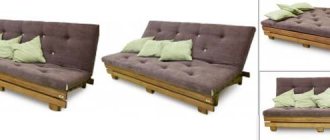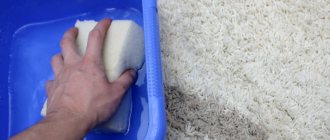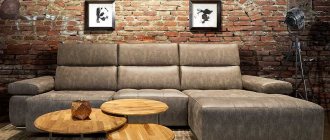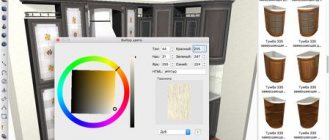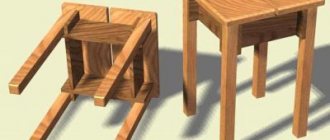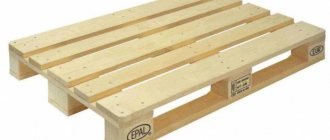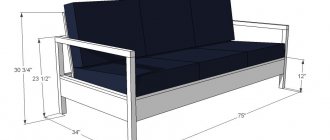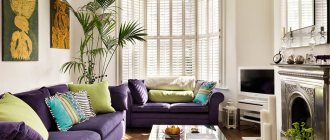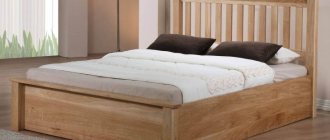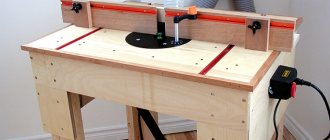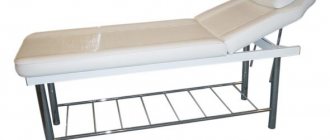Design of custom upholstered furniture
Designer, constructor, planner, developer, technologist for the production of furniture and interior items - all these are facets of my profession. My professional experience began in 1989. For the last 6 years I have been designing furniture remotely, which gives me the opportunity to carry out many very interesting orders for clients from different countries. In the course of my professional activities, I came across a situation where talented furniture makers are not computer friendly, and talented 3D specialists are absolutely unfamiliar with the nuances of furniture production. This is especially true for upholstered furniture, since designing cabinet furniture on a computer is a much simpler process (there are many specialized programs that simplify this activity to the intuitive level of an ordinary computer user). I've done a fair amount of work. I have mastered the computer design of upholstered furniture with the issuance of a full volume of documentation, allowing me to produce real products with minimal expenditure of time, materials and financial resources.
Chair design example
Development drawing of bent parts on a scale of 1:1 for a CNC machine
I can design any furniture, but I prefer soft “a la Italia”, because it is more complex and interesting. In the workflow, you have to use the most powerful arsenal of 3D modeling and design required for each specific task. In my opinion, designing upholstered furniture is more of an art, while designing cabinet furniture is more of a craft. But this is a very crude generalization that ignores many exceptions.
The use of modern technologies such as three-dimensional modeling using CNC equipment in the mass production of furniture allows us to bring serial products to an exclusive level and produce furniture that is not inferior in level to custom-made furniture. Drawings and patterns in electronic form make it possible to quickly, accurately and competently change the dimensions, configuration, configuration and appearance of furniture required at the moment. Modern technologies also reduce the dependence of the quality of furniture on the skill of workers, which in turn provides savings in wages and increases the competitiveness of the product. But as a designer, technology first of all pleases me with the expansion of creative freedom.
Sofa design example
Sofa frame drawing
Before the introduction of 3D modeling into furniture production, many things had to be done by eye, through real trial and error, with double and triple waste of materials and time, and ultimately obtaining inaccurate results. The production, use, and storage of patterns and templates obtained by handicraft methods entail problems associated with wear, damage, and loss. The number of such patterns during intensive production simply goes off scale, making any classification and systematization difficult. As a result, searching and assembling templates for a specific product turns into a nervous puzzle, when it is easier and more correct to do everything again.
I have been producing furniture for more than a quarter of a century, I have experienced several forced moves and each of them added gray hairs to my head, destroying at least half of what I had acquired through back-breaking labor. All factory documentation in electronic form solves this problem once and for all.
All the documentation and patterns of the furniture factory accumulated over the entire period of work are on one flash drive with a password. Your entire business is in your pocket. Life presents dizzying surprises, but no matter what side fortune turns to you, your experience and the entire accumulated database of documents, furniture models, drawings, specifications, patterns, suppliers, clients are always with you, allowing you to easily replicate your business, restore it from scratch, be confident in the future. Show x-th changeable fate!
Documentation standard for upholstered furniture projects
At the moment, there are no GOSTs or standards for documentation for upholstered furniture in electronic form. In my opinion, documents for the production of upholstered furniture must meet the following criteria:
- Drawings, illustrations and specifications must be professional and at the same time understandable to “poorly skilled” workers.
- They should actually be used to produce real furniture, excluding even minor annoying mistakes that are inevitable when designing upholstered furniture “from the head.”
- Patterns of curved parts must be made on a scale of 1:1 for printing on a plotter or printer.
- Visual illustrations must be created so that workers can clearly understand the assembly of the product.
- It is advisable to provide for scalability (for example, two, three, one), if the furniture model allows it.
- Possibility of any additions at your request.
An example of designing an oval sofa
Sofa-4-backrest-1
Sofa-4-backrest-2
You send me by email, WatsApp, Viber or Skype a photo, picture, hand drawing of the furniture that needs to be designed, indicating overall and other dimensions and explanations at your discretion. I will formulate the questions that need to be clarified to complete the project, determine the completion date, price and contact you. I don't take advance payment. The calculation occurs when you see the result.
Time, events, people leave an indelible mark on the intricacies of our neurons, on the one hand, on the other hand, analysis of what is happening removes unnecessary, far-fetched, artificial layers and limitations of the mind like shavings. Life and professional experience allow us to look at many things more abstractly and generally, as if from a bird’s eye view, without getting hung up on the little things. Linking together and comprehending one’s experience with the experience of predecessors, passing on what was received to followers is, of course, not the only, but quite worthy goal.
By working the old fashioned way, we are not just marking time, but setting ourselves back in competitive competition. Whether we like it or not, the cult of consumption, which underlies our modern civilization, dictates its own rules for a comfortable existence in this world. And a swimmer rowing against the current will sooner or later run out of steam and go to the bottom. There are two more options. You can relax and let it carry you wherever it takes you, or you can row in the direction you want without resisting the general flow. The first option is of course heroic and beautiful, but it looks like masochism, bordering on suicide. The second one is too conformist, turning him into a weak-willed rag. I like the third option better, provided there is a reasonable definition of purpose and direction. It allows, without compromising one’s own moral and ethical principles, not only not to fall overboard of historical development, but also to overtake those floating nearby without much effort. My friends, do not let yourself drown in the muddy waves of ignorance and conservatism, rake out the clean waters of innovation and progress. I throw you an oar, catch it.
While walking through furniture stores, you have probably caught yourself more than once thinking that the cost of modern models is quite expensive. In addition, the quality of purchased furniture does not always correspond to its cost. However, those men who know how to handle basic household tools can try to make one themselves. Modern upholstered furniture is made quite easily with your own hands, provided you have accompanying literature and purchase the necessary material.
Software for designing upholstered furniture - specialized software package ASSOL
"FURNITURE FACTORY", March 2004.
Previously, we wrote about ASSOL programs for virtually “dressing up” upholstered furniture using photographs. This article will discuss special programs for automating the 3D design of upholstered furniture and technological preparation and optimization of cutting upholstery fabrics.
3D design programs are widely used in the design of cabinet furniture. However, until recently there was a certain vacuum in the field of upholstered furniture design. This is explained by the fact that the three-dimensional configuration of upholstered furniture is much more complex than cabinet furniture. And if the details of a rigid frame can be quite accurately designed in conventional 3D editors (AutoCAD, Solid Works, etc.) - which is practiced by some designers - then the task of constructing a 3D model of a sofa can only be performed approximately and serves only to assess the overall type of product.
Thus, designers and technologists of upholstered furniture are forced to work the old fashioned way, while their colleagues in cabinet furniture have long been using advanced software products in their daily work.
Demand creates supply
However, in the last six months the situation has changed dramatically. A specialized ASSOL software package for upholstered furniture has appeared. It allows you to design a 3D model based on real dimensions and then automatically obtain parts on a plane to create a set of upholstery patterns. The created patterns are assigned the necessary technological parameters to obtain layouts. Patterns of one model can be sorted by companion fabrics. In the program “Automatic layout of patterns” ASSOL, the necessary parameters of the fabric are set: width, presence and direction of pile, dimensions of the pattern, etc., sets of patterns are selected for the layout. One layout can include patterns from different models. Next, ready-made cutting cards for various widths of upholstery fabric with optimal fabric consumption per model are automatically obtained. These finished cutting cards can then be printed in full size or in miniature, and also transferred to specialized cutting equipment.
Automatic layout of patterns
Depending on the power of the computer and the configuration of the parts, the time to obtain the finished layout is 10-40 minutes. This layout can be manually adjusted, repositioned or rotated, but, as a rule, this is not required, since the Automatic layout program is ahead of the layout specialist in saving fabric by an average of 1-3%. And for fabric with a pattern, where the interconnection of parts or binding to a specific point in the pattern is monitored, the machine’s winnings increase to 5-6%.
Thus, with virtually no human intervention, it is possible to obtain dense layouts of any model. The opportunities that the automatic layout of ASSOL opens up can be used not only for new models, completely designed on a computer, but also for proven “sales leaders” in the sale of models for which complete sets of patterns are available in production. These sets of patterns can be entered into a computer, set the necessary technological parameters and then laid out on all upholstery fabrics used in the production.
Entering patterns into the computer
The task of entering patterns itself, if solved in the traditional way - using a scanner and digitizer, requires significant costs. Furniture patterns are quite large - scanners of this size are expensive and slow, and buying a digitizer* means shelling out $3,000 on bulky equipment that will soon become unnecessary. Back in 2000, the ASSOL Center developed an advanced technology for entering patterns into a computer using a digital camera - Photodigitizer. Since then, not a single enterprise working for ASSOL has purchased a digitizer.
The essence of the new technology is that the patterns are placed one by one on a special marking, photographed with a digital camera and transferred to a computer, where the Photo Digitizer program eliminates all optical and perspective distortions and automatically determines the contours of the patterns. Then all that remains is to set the technological parameters for them and transfer them to the Layouts program. In this case, the areas and perimeters of the patterns are calculated automatically.
The process of entering patterns using the Photo Digitizer is simple and straightforward. Thanks to the automatic elimination of distortions and vectorization of the contours of the patterns, they are guaranteed against human errors, which often occur with the traditional method of input from a digitizer, where the contour of the pattern is specified manually by the technologist. The costs of introducing new pattern input technology are significantly lower than the implementation of traditional input systems. In terms of input speed, the new technology is also ahead of all previously adopted methods. Let’s illustrate the time required for input using the “Photo Digitizer” and the results of the pattern layout machine using a real example.
EXAMPLE
Usually, before an enterprise purchases the ASSOL Automatic Layout, we recommend comparing the results obtained by the program with the results of the layout of the given enterprise. Comparison of results is the best proof of the need to purchase the program.
The Center has accumulated data on the time it took to enter sets of patterns for different models. One typical example: it was necessary to calculate layouts for different widths for a set of patterns for a model of a sofa and two armchairs.
36 different patterns were entered into the computer. Photographing the patterns took 30 minutes - a total of 25 photos were taken, long patterns were photographed in parts. By the way, you can take photographs from any angle, the main thing is that all the patterns and markings fall into the lens (Fig. 1 shows the stages of entering 1 photograph: before processing, distortions are eliminated, contours are vectorized).
Another 30 minutes of computer time were spent on automatic elimination of distortions and vectorization of patterns in the Photo Digitizer program. (Figure 2 shows some photographs after eliminating optical distortions - the effect of a large format scanner with low resolution is achieved. Figure 3 shows the same patterns after vectorization.)
Another 65 minutes were needed to check the patterns, combine parts of the patterns, and assign technological parameters to the patterns for layout.
In total, the total time to enter a set of patterns with a complex configuration is 2 hours.
Simple patterns (rectangular) should not be entered; they are quickly created in the ASSOL program. After that, in the Layout program we set the necessary fabric parameters and launched automatic layout for 4 different widths of pile fabric.
It should be taken into account that long layouts were calculated (the length of the layout at all widths is more than 10 meters). After 3 hours the layouts were ready - see fig. 4. We welcome everyone interested in new production automation technologies at our Center. Automatic layout ASSOL is supplied both with CAD ASSOL and is connected to other systems used in the enterprise. Enterprises that have a manual ASSOL layout receive a discount. Staged payment is possible.
Product selection
So, let's start discussing the process itself in more detail. If making furniture yourself is not new to you, then you can start making quite complex structures. Otherwise, it is best to start by assembling simpler models. The simplest model for making modern upholstered furniture is a square ottoman.
Important! The softness and springiness of the product depends entirely on the purchased foam rubber and its quality.
Sofa book
Making upholstered furniture is not an easy process. It requires accuracy, attentiveness and hard work. We invite you to familiarize yourself with the instructions for making a book sofa, which, when unfolded, will have dimensions of 1400×2200 mm, and when folded, 1000×2200 mm. To do this you will need to prepare the following material:
- board 25 mm thick: 1000×50 (12 pcs.);800×50 (2 pcs.);800×200 (2 pcs.); 1900×200 (2 pcs.);
- timber: 50×50×200 (4 pcs.);40×50×330 (4 pcs.);40×60×530 (6 pcs.);40×60×1790 (2 pcs.);40×60× 1890 (2 pieces);
- glue intended for foam rubber;
- staples for stapler 16 and 10 mm;
- self-tapping screws 89D and 51D;
- nails 70 and 100 mm;
- nuts 8 and 8 mm;
- furniture bolts: 6×70 (8 pcs.); 6×40 (4 pcs.); 8×120 (4 pcs.);
- non-woven fabric – 4 m;
- foam;
- fabric 6 m/p and width 1.4 m;
- Fiberboard 1.7x2.75, thickness 3.2mm (1 sheet);
- holders (64 pcs.) and wooden slats (32 pcs.);
- legs 4 pcs.
- 1 set of mechanism for sofa book.
Also prepare the following set of tools:
- stapler;
- open-end wrenches;
- set of drills;
- drill;
- screwdriver;
- hammer;
- roulette;
- pencil;
- square;
- hacksaw.
If you have all of the above, you can start working.
Step-by-step instruction
The first step is to make frames for the armrest, linen drawer, backrest and seat. First, let's assemble the laundry drawer. To do this you need to use:
- 4 beams 40×50 (50×50) 200 mm long;
- 2 boards 25 mm, 50 mm wide and 800 mm long;
- 2 boards 800 mm long and 200 mm wide;
- 2 boards 25 mm thick (40 mm thick or 20 mm plywood), 1900 mm long and 200 mm wide.
You assemble a frame from boards 800 and 1900 mm long, reinforcing the structure with transverse slats. A fiberboard of the appropriate size is nailed to the bottom of the structure. Next you need to assemble the back and seat of the sofa. The size of the sleeping area should be quite spacious, so take this into account when calculating. So, assemble 2 equal frames, size 1890x650 mm, from 40x60 mm timber. The timber frame is best fastened with self-tapping screws. To do this, pre-drill holes Ø8 mm to a depth of 10 mm. After making the frame, it is necessary to secure the slats to hold the mattress.
Assembling the slats
At the next stage, you make the armrests. For this purpose, you can use chipboard with a thickness of 25 mm. Cut out the left and right armrest according to the dimensions indicated in the photo:
Assembling the back
Next you should make a wooden frame. In this case, it should be 20 mm shorter than the size of the chipboard. Afterwards, you make holes Ø8.5 mm in the frame and insert 8x120 mm bolts into them, and after that the frame is sewn up. Also drill holes on the linen drawer, only Ø10 mm.
Base drawer
Now the individual parts of the sofa are assembled into one whole. A special transformation mechanism is also used. When assembling two frames, take into account the fact that when unfolded there is at least 10 mm between them, and when folded the seat does not protrude beyond the armrest.
Frame assembly
After this, the frame must be sheathed. Foam rubber and prepared fabric are used here. Don’t forget to also cover the armrests with fabric and foam.
Finishing touches
Stages of assembling upholstered furniture
Purchasing filler
One of the most critical stages in the manufacture of upholstered furniture is the purchase of material, which will directly affect the quality of the final result. For more than 10 years, foam rubber or polyurethane has been used as a filler for the product, the thickness of which completely depends on the place where the material is used.
Important! Each part of the furniture installation requires careful selection of filling material. So, for example, for the seat and back of the product, a thicker, more elastic material should be used, and for the side part, a thinner one will do.
Choice of upholstery fabric
If you purchase upholstery fabric yourself, you should give preference to the most durable, practical option that meets the following criteria:
- Possibility of self-removal of stains;
- resistance to physical and mechanical stress;
- resistance to household chemicals.
Selection of base material
As the main material of the product, preference should be given to plywood or, in extreme cases, chipboard. All other materials are more fragile and unreliable for the use of such expensive products.
Creating a Sketch
Like any work, the creation of upholstered furniture begins with the development of a sketch, accurate drawings, and setting dimensions.
Creating a sketch is a labor-intensive, important stage, on the result of which almost the entire success of the work done will depend. Since every unaccounted millimeter will emerge during final assembly and upholstery of the structure.
When creating a schematic representation of the planned model, it is necessary to take into account the relevance of the selected assembly mechanisms, if any, ease of use, the modernity of the model, the number of fittings used to ensure the best performance.
Important! When creating a schematic image, it is necessary to calculate and indicate the location of the connection of parts, fasteners using additional tools, that is, nails, screws, and so on.
Currently, thanks to technological progress, it is possible to create a schematic image in specially developed programs that independently take into account and make adjustments.
Sawing material
Sawing the material can be done in 2 ways:
- independent. Self-sawing is possible when creating the most basic components of a product, using which modern upholstered furniture with your own hands does not require figured cutting, additional large-sized elements, and so on;
- third party. Sawing the material using specialized equipment is performed to create smooth lines, precise cuts, cutting all parts from a large sheet, and so on. The use of specialized equipment to create the basis of modern upholstered furniture is, in some way, the key to proper assembly, and, accordingly, the entire product.
Material marking
After the final cutting of the material, it is necessary to make markings on the components of the product, which will help in the future to avoid the occurrence of curvature, inconsistency, and so on.
Fastening components
Upon completion of the preparatory work, it is necessary to begin the direct assembly of the parts, during which both self-tapping screws and additional fittings are used to ensure the movement of the components of the model.
Attaching foam rubber to the walls of the product
The inner foam rubber is attached to the walls of the product using special glue, which ensures the reliability and durability of the product. Often, it is not worth skimping on purchasing such glue, since additional reworking of the entire product will cost much more.
Fastening of foam rubber is carried out only after direct cutting of the components of the product and fitting. Also, when attaching the foam rubber, it is necessary to ensure softness in all connecting and transitional places. For example, such places could be: joints, side, and so on.
Making a case
Sewing a fabric cover is not always done in the traditional way. Over the past few years, furniture staplers have gained popularity; the quality of fastening staples is no worse than a solid cover.
Important! By giving preference to using a stapler, you not only significantly save time, but also the amount of material used. Using a furniture stapler, you can recreate any shape without making patterns, but only by tensioning the fabric.
By creating furniture with your own hands, everyone has the opportunity to test their strength as a designer-developer, process engineer, or assembler of upholstered furniture.
Corner sofa
Corner design
To make a corner sofa, it is not necessary to use complex connections, for example, tenon products, or expensive materials. For work, we suggest using the following material, the volume and quantity of which depends on the size:
- timber 30×50 mm;
- chipboard;
- Fiberboard;
- plywood, thickness 5 and 15 mm;
- self-tapping screws and wood screws;
- nails;
- synthetic winterizer, with a density of 140–170 g/day;
- batting;
- foam rubber, 20 and 40 mm thick with a density of at least 30 kg/m 3 ;
- glue for foam rubber and wood glue;
- foam crumbs;
- furniture fabric;
- lifting mechanism;
- furniture legs 5 cm high.
It is not recommended to use nails when connecting parts. They will quickly become loose, and the sofa will creak and, as a result, fall apart. Therefore, it is best to use self-tapping screws for connections.
As for the tool, for work you will need:
- wood hacksaw;
- miter box;
- screwdriver;
- stapler;
- sewing machine;
- knife.
Configurations and sizes of corner sofa blocks
Each structural block is made of a frame based on timber, chipboard and plywood. The internal space in blocks 1 and 2 can be used rationally by making removable covers. To support them, a 20x30 mm beam is fixed around the perimeter of the frame. It is installed below the top cut to the thickness of the cover plate. To make it easier to lift the lid, you can drill holes in it for your fingers.
Frame design block 1
Blocks 1 and 2 are the same in design. The only difference is their size. The first block is 100x60 cm in size, and the second is 60x60. It is the second block that will be located in the corner of the structure and connect the first and third blocks. As for the third block, you can make a drawer-seat in it. Due to this, the usable area of the sofa will increase. To do this, you can install a retractable or rotating mechanism.
The drawer will also be equipped with a chipboard lid. While assembling it is not difficult, difficulties may arise when making the legs. Why? When sliding the drawer into the body of the sofa, they will interfere. Therefore, instead of legs, it is necessary to increase the height of the front side of the drawer. When unfolding the corner sofa, it will serve as a support platform. To make the drawer easy to pull out, you can attach furniture wheels to the bottom.
Block 3
The cover for the third block (indicated in the diagram) can also be made removable. For example, you can fold bed linen inside.
The size of the seat cushion should be equal to the size of the drawer. Therefore, when the drawer is pulled out, the pillow is removed from the back and placed on it instead of the mattress.
Design of the back of the corner sofa
Now it's time to make the back for the corner sofa. The manufacturing process looks like this:
- Place 3 beams horizontally and, as in the illustration, connect them with vertical posts. The height of the back in our case will be 105 cm.
- The lower second beam will be located at a height of 25 cm. They will serve to fix the backrest to the sofa.
- The top beam will be used as the basis for fastening the sheathing and provide the necessary rigidity of the structure.
- The frame is sheathed on both sides with plywood 5 mm thick.
- To avoid snags and unevenness when laying upholstery fabric, sand all corners with sandpaper.
- Glue thin foam rubber onto the side and front surfaces, due to this the upholstery will be soft.
Finally, all that remains is to cover the entire sofa, including the backs, with the selected material.
Attaching the upholstery
Before doing this, take all the measurements, and then cut out the fabric with an allowance for the hem. You can fasten the material with a stapler. The mounting location should be on the invisible part of the panel end. Make sure that the fabric does not wrinkle at the corners. As for the manufacture of pillows for the back and seat, they can be made from foam rubber with a density of 140–170 g/day and a thickness of at least 10 cm. You will also need to sew a cover with a zipper. This will allow you to remove the cover and wash it if necessary.
Video: DIY upholstered furniture
What exactly are they, and what information do they carry?
And they are an image of furniture (in projections) with overall and main dimensions indicated.
Based on these drawings, all the details of the future product are calculated.
In other words, the furniture drawing is the source material for calculating the entire project (this is a package of “documents” on the basis of which the furniture in question can be manufactured, assembled and installed).
What are the drawings for? We figured it out.
Now let's talk about how to make them?
And making a drawing is not as easy as it seems at first glance (I’m already repeating myself, but this is actually true).
To create a drawing you need:
- Know the dimensions of the room (or part of the room) where the furniture is planned (in some cases, this is not required, for example, when you just need to make a chest of drawers of a certain size that will not be associated with the nuances of a certain room).
- Understand the size of the gaps (in the case of built-in furniture, for example, a kitchen set) that must be given for the overall dimensions of the product.
- Understand the dimensions of the designed modules in accordance with the built-in fittings (for example, the same built-in guides for drawers).
- Correctly design the design of the product to ensure its maximum rigidity (sizes of modules, presence of stiffeners).
- Take into account the dimensions of the components (parts) of the product relative to the dimensions of the sheet material from which these parts will be made (so that it does not turn out that, for example, the designed side of a sliding wardrobe will be larger than the dimensions of the sheet of material from which it should be made).
- Understand the geometry of some parts (for example, the facade, which is attached to the frame on hinges, must have a height greater than the width, in order to avoid unnecessary load on these hinges).
- Regarding the overall dimensions of the entire structure, you also need to understand its stability (for example, if the structure is tall and narrow, it will not be stable). In the case of low stability, you need to be able to plan options for attaching such a structure to the wall (as, for example, shown in this article).
- Understand what dimensions furniture niches should have in order to plan drawers in them (there is no point in planning drawers that are too small (in width), just as there is no point in planning drawers that are too large, for a number of reasons...).
Here are the main points of making, so to speak, a semi-finished product for making a project - a drawing.
Now let's look at all of the above with a simple example:
This option will save you from mistakes and provide you with a high-quality furniture project that you want to make with your own hands.
Well, I’ll end here.
We wish you beautiful and high-quality furniture!
After finishing the renovation of the living space, the last crucial moment comes - choosing suitable furniture. Upholstered furniture design programs allow you to create modern, convenient, comfortable and practical interior items that can not only complement, but also change the interior without large financial investments. Specially developed software makes it possible to create sketches from which craftsmen will subsequently produce furniture. An example of designing upholstered furniture in AutoCAD
Design programs
Despite the fact that there are few programs for designing upholstered furniture, they still exist. It is worth paying attention to the following utilities for designing furniture for your home.
Solid
This software allows you to design complex structures. In particular, it is often used to create frame projects for upholstered furniture.
Interface of the Solid program for furniture design
Advantages
- You can work in the system both in the Russian-language interface and in the English-language one. Therefore, everyone will choose for themselves what is most convenient;
- Using the Solid program, you can create different models of upholstered furniture, taking into account dimensions, fasteners and drawings. Consequently, the utility will help you calculate in detail the amount of necessary materials for further calculation of the cost of the finished product;
- The program's firmware contains a set of tools and tools necessary for operational modeling of projects. This will allow you to design any model of upholstered furniture without additional time;
- after creating the frame of a soft sofa or chair, the product can be viewed in 3D mode, assessing all the advantages and disadvantages of the selected model;
Project and drawing with dimensions of a soft sofa frame
Flaws
- To use this system, you must have at least minimal experience in working with such utilities. If you don’t have one, then you should turn to professionals to implement the creation of the project.
This program has many advantages. In addition, there are not too many analogues to such a utility, so you won’t have to choose for a long time. After creating the frame of a soft sofa or chair in this program, you need to process the product using other resources to give it a finished look.
Assol
This program is widely popular among manufacturers of upholstered furniture, as well as among people who plan to create an interior design for their apartment.
Advantages
- the software allows you to design a disassembled model of a sofa or chair based on the entered parameters and dimensions;
- Thanks to the wide capabilities of the Assol program, anyone can create an upholstered furniture project online and decide which one will fit most harmoniously into the interior;
- The functionality of the system allows you to ideally select color solutions for interior items. Thanks to the rich palette included in the content of the utility, everyone will be able to conduct experiments and see the desired sofa or chair in different variations;
- The program contains free tools (patterns, textures, textures).
Project of a soft sofa created in the Assol program
Thanks to this, everyone will be able to turn a variety of ideas into reality by visualizing their fantasies. Different textures will help you see in detail what the finished piece of furniture will look like;
- The Assol program allows you to see the created project in 3D mode, which will help you clearly determine whether the correct model of headset has been selected for placement in the space of the room.
- There are some peculiarities in working with the system, so you should undergo video training before starting to work with the utility.
Flaws
The software allows you to carry out the process of forming a project from beginning to end, seeing the finished model of the headset in the form in which it will appear to the customer after it is completely ready.
3d MAX
This utility is popular among craftsmen and designers of upholstered furniture.
An example of creating an upholstered furniture project in the 3D max program
And this is not surprising, because this software can fully satisfy the needs and requirements of a customer or a person who, on his own, creates an interior for his apartment or house on the Internet.
Advantages
- accessible and visually understandable interface;
- The utility has the ability to design furniture models in 3D format. This will allow you to see the piece of furniture in the form in which it will appear in the apartment;
- the ability to experiment with both color combinations and shadows that can be displayed on an object;
- thanks to this utility, the user will create a complete and full-fledged model of a sofa or armchair, which will help to see it and understand exactly whether this is what was dreamed of;
- The program allows you to print a drawing of the created model so that upholstered furniture designers can immediately begin assembling a soft sofa or armchair.
Video lesson on designing upholstered furniture in the 3D MAX program.
Flaws
- In order to easily use the program, you need to complete a video training course in the right direction. This will help you easily master all the functionality required to implement your idea.
Everyone will be able to choose a way to create upholstered furniture for their home or apartment, which is as clear and accessible as possible. In any case, seeing the interior items at the stage of planning the space of the rooms will help you accurately determine which furniture will look more harmonious and aesthetically pleasing in the room.
Source
Modern upholstered furniture
Currently, the global and domestic upholstered furniture market offers many different models that are designed for individual rooms in the house. A lot of positive things are caused by the abundance of materials that are used in the manufacture of furniture: high-quality plastic, various metals, wood, glass, leather and others.
New models of upholstered furniture, manufactured at factories of popular European brands, are always distinguished by their unique design and abundance of colors that decorate any interior. Furniture made from natural materials is extremely popular. As a rule, such models of upholstered furniture are expensive, but the increased level of comfort is worth the money.
Exquisite upholstered furniture from Milan-1
Shield
Self-assembly of a sofa
This method is suitable for people who do not have skills in working with wood. This option is a little simpler and to implement it you need to stock up:
- two used door leaves;
- metal staples;
- wood hemp;
- foam;
- upholstery material.
Wooden version
The base and back of this sofa model will be two used wooden door leaves. You will need to first clean them of old coatings and dirt, and then treat them with a grinding machine.
Next, the doors are painted in the color of your choice, while trying to ensure that it matches the overall interior of the room in which the sofa will be installed in the future. You may prefer finishing the wooden surface with veneer.
Sketches of a new product: first steps
In order to create a sketch of upholstered furniture, you need to have free time and inspiration, as well as an appropriate modern program.
If experience is not enough, the first steps in design can be taken using simple programs. At the very beginning, you can use photographs from the Internet, as this will help in choosing the direction of further work. Design allows you to decide on the direction of work, since even professionals cannot do all the elements with the same quality.
Steps to create upholstered furniture
In order to create a sketch of a sofa or armchair, you need to decide on the dimensions and calculate all the dimensions. They depend, first of all, on what mechanism will be embedded in the product, what shape it will be - straight or angular.
Creating a sketch and design of a sofa in a special program It is important to remember that the mechanism is demanding on the size of the furniture, which has a huge impact on the overall dimensions, depth, width and height of the future furniture frame. Thus, roll-out mechanisms require a large frame depth.
Design software
Designing upholstered furniture according to a specific order and taking into account the special wishes of the customer is quite a complex job, requiring not only professional skills, but also an original design vision. In such cases, software packages for three-dimensional design are actively used.
Modern graphic editors, such as Assolili 3D Max, have the necessary software tools to highlight the smallest details of a future product.
Any program for designing and creating unusual, practical and comfortable furniture can be used, the main thing is that it is understandable to the person working in it.
Designing an upholstered sofa in a special program Today, the choice of developments in this area is large, the only drawback that you should pay attention to is that there are no programs specifically for upholstered furniture, so it is better to use software designed for cabinet furniture, and then complete it with third-party developments.
What to pay attention to
When designing ordinary cabinet furniture, everything is simple, just select the desired shape, design, fasteners and the drawing template is ready. With upholstered furniture, things are a little different. It is important to understand what details must be present in upholstered furniture, so as not to miss something important.
Frame
Various materials and fasteners can be used to design the frame.
Also, for the basis of upholstered furniture, it is important that the design contains reliable movable parts, thanks to which the mechanism will unfold and fold.
Therefore, when creating a frame project for upholstered furniture, it is necessary to pay attention to the following nuances:
- what material is specified in the project;
- Is there enough fastening elements on the sketch, which are the basis for the durability and stability of the structure;
Drawing with dimensions of a soft corner for the kitchen
- what mechanism for dismantling the structure is specified in the project.
Padding
It is very important that in the process of creating an upholstered furniture project, such an important point as the internal content is not forgotten. This happens:
- foam;
- felt;
- batting;
- padding polyester;
- latex.
Each of these materials has its own useful functions, so it is necessary to take this fact into account during the project development process.
Upholstery coating
This question is also important in the process of drawing up the design of a future sofa or chair. It is important not to lose sight of this point, because the absence of this seemingly trifle can lead to rapid damage to the product. As a rule, the padding is covered with nylon, which protects the fabric from rapid wear and contamination from the inside.
Upholstery
The above factors are important for the comfort and durability of the products. The appearance of the product plays a greater role than the quality parameters.
Design of upholstery material in a special program
Therefore, design is the nuance that, perhaps, is paid most attention to when creating a furniture project for an apartment or house. In the upholstery you need to pay attention:
- on the color scheme;
- material;
- combination of raw materials with each other.
Often people choose upholstered furniture made from natural raw materials. This is justified by the fact that this furniture option not only fits harmoniously into the space and layout of any apartment interior, but is also beneficial for the health of the residents of the house. Therefore, when drawing up a project, it is worth paying tribute to the selection of furniture made from natural raw materials.
